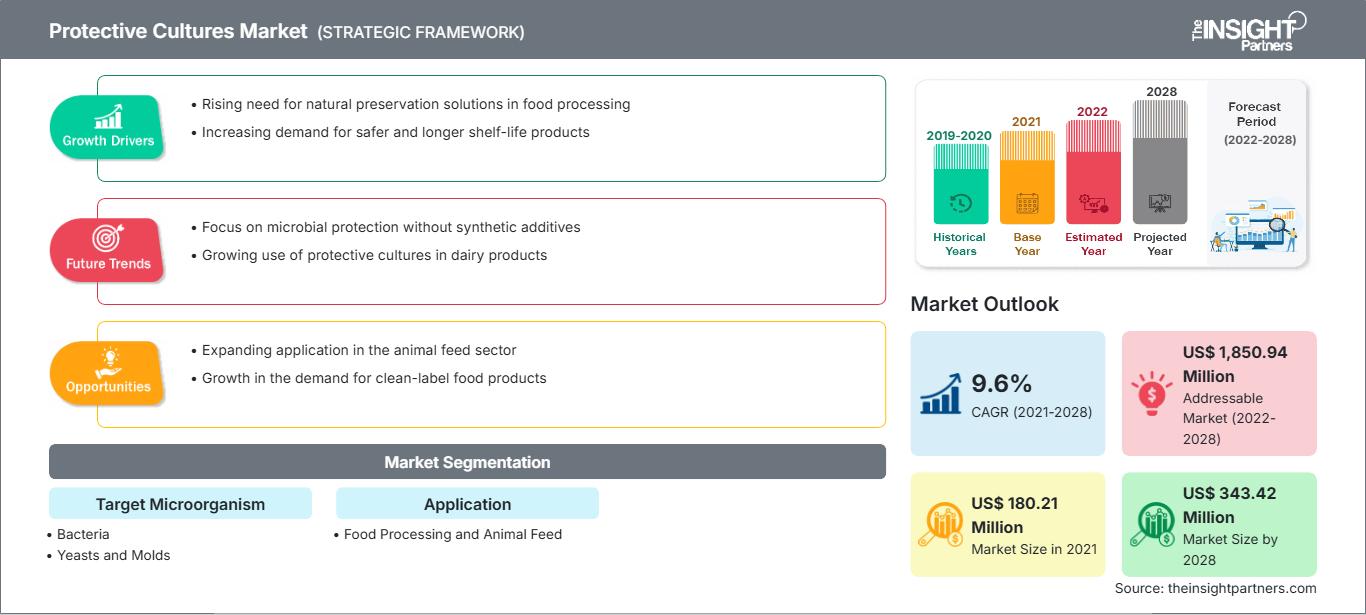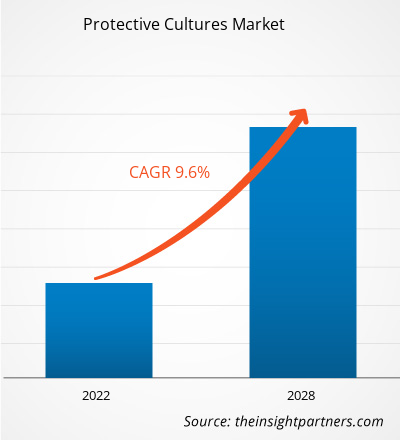[연구 보고서] 보호 배양균 시장은 2021년 1억 8,021만 달러에서 2028년 3억 4,342만 달러로 성장할 것으로 예상되며, 2021년부터 2028년까지 연평균 성장률 9.6%로 성장할 것으로 예상됩니다.
전 세계적으로 천연 및 화학 방부제가 없는 제품에 대한 수요 증가와 유통기한이 긴 부패하기 쉬운 제품에 대한 수요 증가가 보호 배양균 시장의 성장을 견인하고 있습니다.
아시아 태평양 지역의 보호 배양균 시장은 예측 기간 동안 가장 높은 연평균 성장률을 기록할 것으로 예상됩니다. 중국은 가장 중요한 유제품 시장이며, 유제품 소비 증가가 주요 원인입니다. 천연 스낵, 사워 밀크와 같은 발효 유제품, 요구르트와 같은 유제품에 대한 수요 증가와 더불어 제품 및 포장 혁신이 아시아 태평양 지역 유제품 시장의 성장을 견인하고 있습니다. 따라서 유제품 소비 증가와 병원성 및 부패성 미생물의 증식 억제 등 보호 배양균의 이점 덕분에 보호 배양균 시장은 향후 몇 년 동안 상당한 성장을 보일 것으로 예상됩니다. 더욱이, 아시아권에서 천연 및 클린 라벨 제품에 대한 인식이 높아지면서 시장 확대에 기여하고 있습니다.
요구 사항에 맞게 이 보고서를 사용자 정의하십시오.
이 보고서의 일부, 국가 수준 분석, Excel 데이터 팩을 포함하여 모든 보고서에 대한 사용자 정의를 무료로 받을 수 있을 뿐만 아니라 스타트업 및 대학을 위한 훌륭한 제안 및 할인을 이용할 수 있습니다
보호 문화 시장: 전략적 통찰력

-
이 보고서의 주요 주요 시장 동향을 확인하세요.이 무료 샘플에는 시장 동향부터 추정 및 예측에 이르기까지 데이터 분석이 포함됩니다.
COVID-19 팬데믹이 보호 배양균 시장에 미치는 영향
현재 진행 중인 COVID-19 팬데믹은 보호 배양균 시장에 비교적 긍정적인 영향을 미쳤습니다. 이 팬데믹은 미생물 배양균에 대한 관심과 인식을 높이는 데 도움이 되었습니다. 이 위기는 전 세계 대부분의 사람들에게 불쾌하고 스트레스가 많은 시기였습니다. 따라서 전 세계 사람들이 클린 라벨 제품을 소비하기 시작했습니다. COVID-19 팬데믹 이후 사람들은 음식에 더욱 조심스러워졌고 평소보다 건강한 음식을 섭취하고 있습니다. COVID-19 팬데믹은 라벨이나 제품을 넘어 소비자의 클린 라벨에 대한 인식을 변화시켰습니다. 소비자들은 집에서든 밖에서든 클린 라벨에 계속 집중하고 있으며, 이는 다양한 식품 분야에서 클린 라벨 적용을 증가시키고 있습니다. 더욱이, 2021년 대부분 국가의 경제 성장 전망은 낙관적입니다.
시장 분석
유제품 소비 증가
전 세계적으로 유제품 시장은 변화하고 있습니다. 소비자들은 더 적은 성분 표시와 더 투명한 제품 라벨을 갖춘, 건강에 좋고 자연적이며 지속 가능한 유제품을 선호합니다. 현대인의 바쁜 생활 방식과 함께, 신선도를 유지하기 위해 냉장 보관할 필요 없이 이동 중에도 간편하게 섭취할 수 있는 제품에 대한 수요가 증가하고 있습니다. 유제품 제조업체는 유통기한 동안 부패를 방지하여 수익을 증대하고, 천연 및 클린 라벨 제품에 대한 소비자의 요구를 충족하는 데 있어 보호적인 문화가 매우 중요합니다. 또한, 요구르트, 버터, 치즈와 같은 유제품 소비가 전 세계적으로 급증하고 있습니다.
치즈는 전 세계적으로 일상 식단의 주요 구성 요소가 되었습니다. 미국 농무부에 따르면 2017년 미국에서 5,733톤의 치즈가 생산되었으며, 북미 사람들은 연평균 약 6,626톤의 치즈를 소비합니다. 치즈 시장은 리스테리아균에 대한 특수 보호 배양균 덕분에 보호 배양균의 주요 최종 사용자 중 하나이기도 합니다. 이 보호 배양균은 락토바실러스 플란타룸(Lactobacillus plantarum)으로 만들어졌으며, 고위험성 붉은 얼룩 표면 숙성 치즈에서 리스테리아균 형성을 예방하는 데 효과적입니다. 따라서 앞서 언급한 요인들이 보호 배양균 시장의 치즈 수요를 견인하고 있습니다. 또한, 듀폰 다니스코(DuPont Danisco)와 크리스 한센(Chr Hansen)과 같은 기업들은 광범위한 유제품 보호 배양균을 통해 유제품 시장에서 상당한 입지를 확보하고 있습니다. 천연 및 건강 유제품에 대한 수요가 증가함에 따라, 클린 라벨 및 그린 라벨 제품에 대한 유제품 업계의 수요가 급증하고 있습니다.
대상 미생물 분석
대상 미생물을 기준으로 보호 배양균 시장은 박테리아, 효모 및 곰팡이로 나뉩니다. 효모 및 곰팡이 부문은 2020년에 더 큰 시장 점유율을 차지했습니다. 효모는 곰팡이와 버섯을 포함하는 대규모 생물군인 균류의 하위 집합입니다. 이들은 일반적으로 특수한 환경에서 살도록 진화한 단세포 생물입니다. 효모는 일반적으로 피클, 메이플 시럽 등과 같이 염분이나 당분이 높은 식품에 서식하며, 이는 식품의 변질을 유발합니다. pH가 낮은 과일과 액체도 다른 표적이며, 육류와 치즈 표면에서 자라는 효모도 있습니다. 곰팡이는 수백만 개의 미세한 세포로 구성되어 있으며, 이들이 서로 연결되어 사슬을 형성하며 빵, 과일, 축축한 종이 및 기타 표면에서 발견될 수 있습니다. 건조 식품, 소금에 절인 생선, 과일, 젤리, 빵, 피클, 잼 및 기타 유사 제품을 손상시킬 수 있습니다.
응용 분야 분석
보호 배양균 시장은 용도에 따라 식품 가공과 동물 사료로 구분됩니다. 식품 가공 부문은 2020년에 더 큰 시장 점유율을 차지했으며, 동물 사료 부문은 예측 기간 동안 시장에서 더 높은 연평균 성장률(CAGR)을 기록할 것으로 예상됩니다. 식품 가공은 유제품, 음료, 육류, 가금류, 해산물 등 다양한 산업으로 구성됩니다. 특히 유제품, 육류, 해산물 산업에서 보호 배양균 사용이 증가하고 있는데, 이는 보호 배양균이 일반적으로 안전하다고 인정(GRAS)되고 많은 식품의 미생물총에 자연적으로 풍부하게 존재하기 때문입니다. 또한, 유통기한이 긴 제품에 대한 요구로 인해 식품 가공업체들은 보호 배양균 사용을 점점 더 늘리고 있습니다. 또한, 소비자들은 부패와 곰팡이 증식으로 인해 많은 양의 음식물 쓰레기가 발생한다는 사실을 인식하고 있습니다. 이는 식품 가공업체의 수익성에도 영향을 미칩니다. 따라서 가공업체들은 식품 폐기물을 줄이기 위해 보호 배양액을 사용합니다. 따라서 식품 산업에서 이러한 제품에 대한 수요가 증가하고 있습니다. 보호 배양액은 유제품 생산업체가 유통기한 동안 부패를 방지하고, 유통기한을 연장하는 동시에 천연 및 청정 제품에 대한 소비자 수요를 충족시켜 제품을 개선하는 데 중요한 역할을 합니다.
보호 배양액 시장에서 활동하는 몇몇 업체로는 Biochem Srl, Bioprox, Chr. Hansen Holding A/S, Meat Cracks Technologie GmbH, DSM, Lallemand Inc., International Flavors & Fragrances Inc., Kerry Group, Sacco System, Dalton Biotechnologies Srl 등이 있습니다. 주요 기업들은 인수합병, 연구 개발 등의 전략을 통해 고객 기반을 확대하고 글로벌 시장에서 상당한 점유율을 확보하며, 이를 통해 전 세계적으로 브랜드 인지도를 유지하고 있습니다.
보호 문화 시장 지역별 통찰력
The Insight Partners의 분석가들은 예측 기간 동안 보호 문화 시장에 영향을 미치는 지역별 동향과 요인을 면밀히 설명했습니다. 이 섹션에서는 북미, 유럽, 아시아 태평양, 중동 및 아프리카, 그리고 중남미 지역의 보호 문화 시장 부문 및 지역별 현황도 다룹니다.
보호 문화 시장 보고서 범위
| 보고서 속성 | 세부 |
|---|---|
| 시장 규모 2021 | US$ 180.21 Million |
| 시장규모별 2028 | US$ 343.42 Million |
| 글로벌 CAGR (2021 - 2028) | 9.6% |
| 이전 데이터 | 2019-2020 |
| 예측 기간 | 2022-2028 |
| 다루는 세그먼트 |
By 표적 미생물
|
| 포함된 지역 및 국가 |
북미
|
| 시장 선도 기업 및 주요 회사 프로필 |
|
보호 문화 시장 참여자 밀도: 비즈니스 역학에 미치는 영향 이해
보호 문화 시장은 소비자 선호도 변화, 기술 발전, 그리고 제품 효능에 대한 인식 제고 등의 요인으로 인한 최종 사용자 수요 증가에 힘입어 빠르게 성장하고 있습니다. 수요가 증가함에 따라 기업들은 제품 라인업을 확장하고, 소비자 니즈를 충족하기 위한 혁신을 추진하며, 새로운 트렌드를 적극 활용하고 있으며, 이는 시장 성장을 더욱 가속화하고 있습니다.

- 을 얻으세요 보호 문화 시장 주요 주요 플레이어 개요
보고서 스포트라이트
- 보호 문화 시장의 진보적인 산업 동향은 플레이어가 효과적인 장기 전략을 개발하는 데 도움이 됩니다.
- 선진국 및 개발도상국 시장에서 채택한 사업 성장 전략
- 2019년부터 2028년까지 보호 문화 시장에 대한 정량적 분석
- 보호 문화에 대한 글로벌 수요 추정
- 포터의 5가지 힘 분석
- 경쟁 시장 시나리오를 이해하기 위한 최근 개발
- 시장 동향 및 전망과 보호 문화 시장 성장을 주도하고 제한하는 요소
- 상업적 관심을 뒷받침하고 시장 성장을 이끄는 시장 전략을 강조하여 의사 결정 프로세스 지원
- 다양한 노드에서의 보호 문화 시장 규모
- 시장의 자세한 개요 및 세분화, 그리고 보호 배양 산업 역학
- 성장 기회가 유망한 다양한 지역의 보호 배양 시장 규모
대상 미생물별 보호 배양 시장
- 박테리아
- 효모 및 곰팡이
응용 분야별 보호 배양 시장
- 식품 가공
- 유제품
- 음료
- 육류, 가금류 및 해산물 제품
- 기타
- 동물 사료
회사 프로필
- Biochem Srl
- Bioprox
- Chr. Hansen Holding A/S
- Meat Cracks Technologie GmbH
- DSM
- Lallemand Inc.
- International Flavors & Fragrances Inc.
- Kerry Group
- Sacco System
- Dalton Biotechnologies Srl
- 과거 분석(2년), 기준 연도, CAGR을 포함한 예측(7년)
- PEST 및 SWOT 분석
- 시장 규모 가치/거래량 - 글로벌, 지역, 국가
- 산업 및 경쟁 환경
- Excel 데이터세트
최근 보고서
사용 후기
구매 이유
- 정보에 기반한 의사 결정
- 시장 역학 이해
- 경쟁 분석
- 고객 인사이트
- 시장 예측
- 위험 완화
- 전략 기획
- 투자 타당성 분석
- 신흥 시장 파악
- 마케팅 전략 강화
- 운영 효율성 향상
- 규제 동향에 발맞춰 대응






















 무료 샘플 받기 - 보호 문화 시장
무료 샘플 받기 - 보호 문화 시장